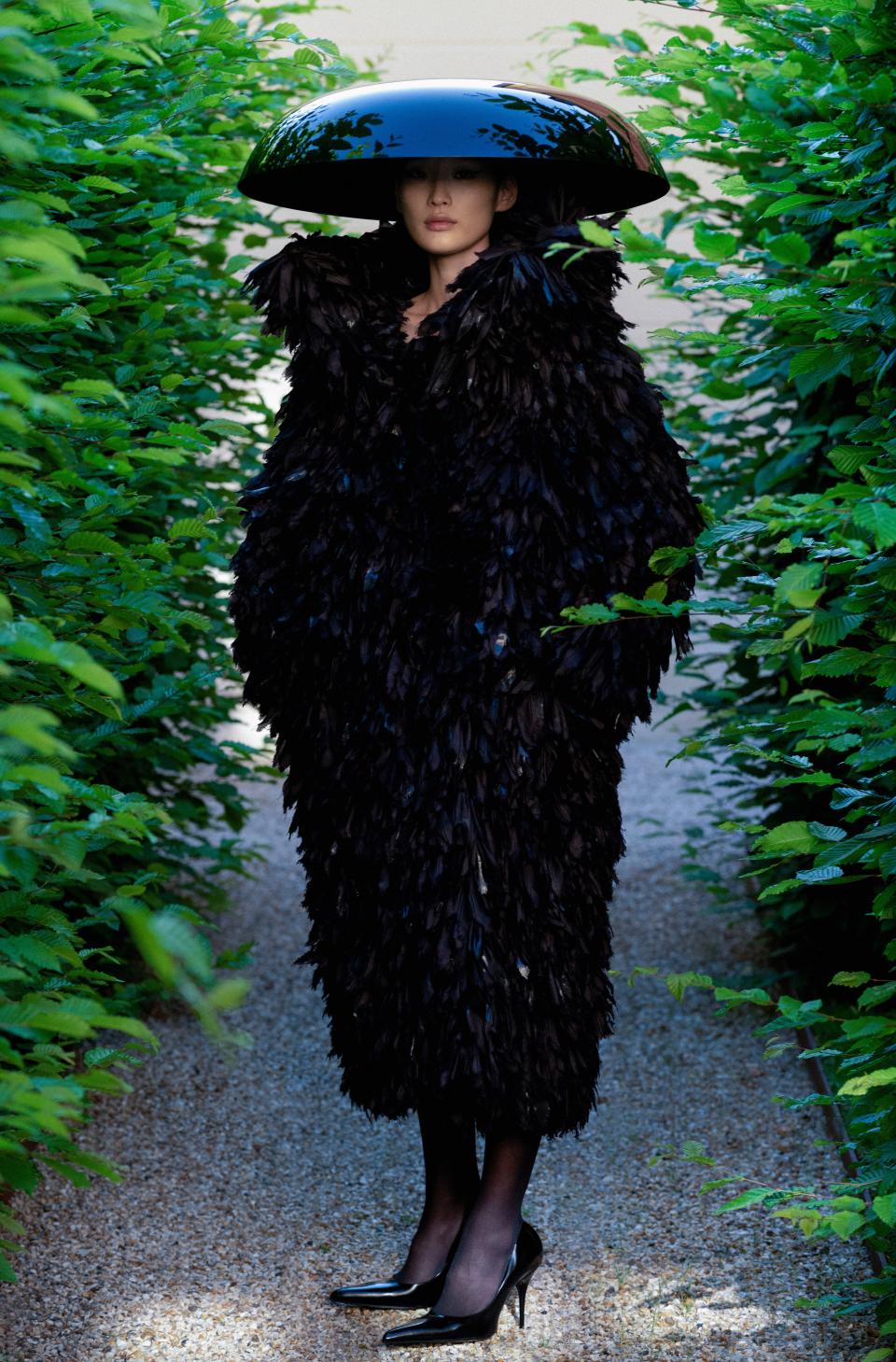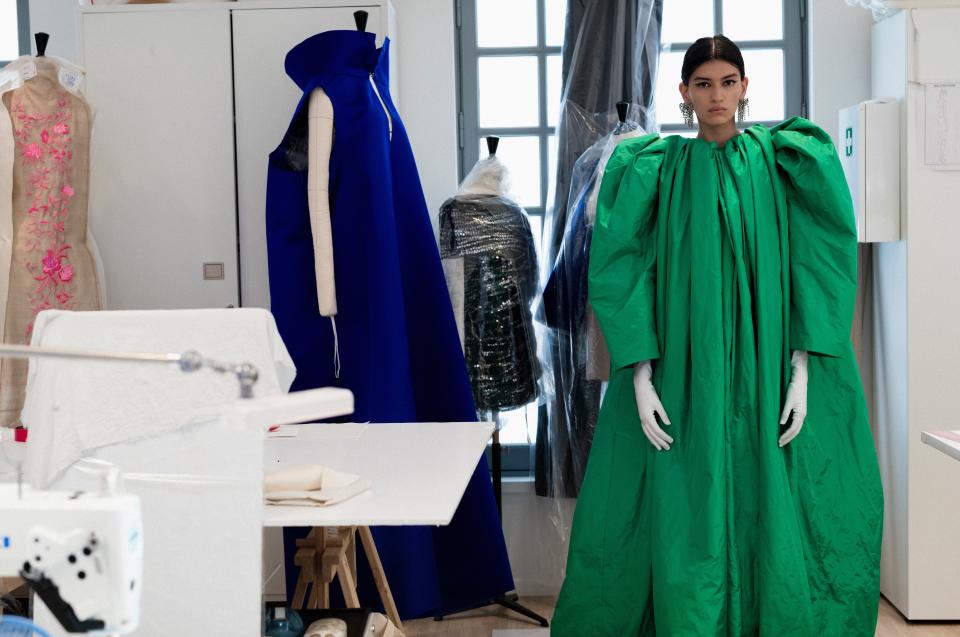‘It’s the Cherry On Top’: Demna Gvasalia Brings Haute Couture Back to Balenciaga
- Oops!Something went wrong.Please try again later.
For Demna Gvasalia, Balenciaga’s artistic director, the haute couture—reintroduced to the storied brand on July 7 (for the first time since its founder retired in 1968) with a powerful, elegant presentation, shown in silence and fragranced with incense, that managed to be both reverential and iconoclastic—is “almost like a holy grail, like an altar in a church.” When he joined Balenciaga in 2015, Gvasalia was well aware of the house’s history and its roots in impeccably conceived, handcrafted couture under the direction of Cristóbal Balenciaga, a humbly born Spaniard whom Christian Dior hailed as “the master of us all.” Balenciaga shaped fashion from 1937—after he fled the Spanish Civil War to establish his already two-decade-old brand in Paris—until he shuttered his house in 1968 (complaining bitterly that his career in couture, during which he dressed the most stylish and demanding women of the century, was “a dog’s life”).
“The reason for him closing was actually the birth of ready-to-wear,” says Gvasalia, in the weeks leading up to the show. “Today we can come back to couture, thanks to ready-to-wear’s success.” Gvasalia’s approach to Balenciaga is centered on what he calls an “aesthetic pyramid.” At the base, as he explains, are “cool sneakers, then a fashion layer—more streetwear-oriented fashion, easy to wear, everyday,” and then “more conceptual, upscale fashion—a level above the streetwear.” Above that, he says, “I felt there was this big black hole.
“A lot of people see me in the context of streetwear, but that’s not at all how I see myself as a designer,” Gvasalia continues. But why couture now? “To be honest,” he confides, “I needed some time to earn some ‘economic credibility’—I won’t call it money—to afford to do couture! I needed to work all these layers in the pyramid. [And] I needed this time to get in the comfort zone for myself—I wouldn’t have dared until recently.”

Model Yoonmi Sun wears a Balenciaga Couture coat— inspired by Cristóbal Balenciaga’s fall 1950 collection. Domed hat by Philip Treacy.
To immerse himself and his chosen cabine of models in the haute couture mood, Gvasalia projected a remarkable series of films of Cristóbal Balenciaga’s haute couture presentations—shot by photographer Tom Kublin from 1960 to 1968—on a giant screen in his atelier during fittings. Unlike the electrifyingly atmospheric, fast-paced, and lavishly produced spectacles that Gvasalia himself masterfully stages, those earlier shows were very different affairs. As the footage reveals, the couturier’s models (who were, famously, chosen for their supercilious hauteur rather than their looks, while Gvasalia’s pan-generational casting deliberately challenged conventional beauty tropes to focus on presence and character) slunk through the salons, removing their jackets and coats with jerky movements and holding up cards with the number of the outfit, while a scattering of clients gossiped and chain-smoked—and, occasionally, simply got up and left. (The collections were shown every day for several weeks, so the privileged customers—and the store buyers and manufacturers looking for inspirational clothes to copy for their own customers—who had passed muster with the terrifying directrice, Mademoiselle Renée, came and went at will.)
While he worked on his own fittings, “that Cristóbal Balenciaga aesthetic spirit was present,” Gvasalia says—something that inspired him to make hats for the first time, resulting in dramatic, flying-saucer creations in collaboration with Philip Treacy. “I discovered millinery!” Gvasalia exults. A hat, he avers, “is such a weird object—I’ve been doing baseball hats, but this is a new experience.”
Gvasalia also felt strongly about the importance of having an “iconic address—like Chanel has the rue Cambon,” he says. “At Balenciaga, we are kind of like a nomad.” Gvasalia discovered that Cristóbal Balenciaga’s original salons, at 10 Avenue George V, were presently being used as storage, which for him was “blasphemous. I felt very sad—I wanted to give this address back to the house.” In reclaiming the space as the house’s haute couture salons once again, Gvasalia envisaged an experiment in time travel—“as though when they closed the house in ’68, the door was locked, and we just reopened it now.” Following a meticulous restoration that involved researching and using authentic 1950s paint, and adding a Sleeping Beauty–like layer of patina—replete with flaking plaster and trompe l’oeil water damage—the reborn space was used to present Gvasalia’s debut collection. “It’s a tiny, tiny place,” he says, laughing. “After all these huge [pre-pandemic] shows, I have the smallest backstage I’ve ever had—but couture is such an exclusive thing, [and] that makes it really special.”

Model Celeste Romero wears a Balenciaga Couture opera coat, gloves, and archival earrings.
Gvasalia has been inspired by the house’s extensive archives since he first arrived: Witness his fall 2016 debut, with its molded-hip suits and dramatic off-the-shoulder neckline treatments employed on parkas and puffers; or fall 2017, with its reimagining of Cristóbal Balenciaga’s sensationally proportioned 1950s evening gowns. Gvasalia describes his research as “Cristóbal’s master class. It was really important to spend some time with the actual pieces and the prototypes and the sketchbooks and the notes and personal things that belonged to him to understand the way he saw the relationship between the body and the dress. Then when you go into the prototype mode, it is much easier to…I wouldn’t say to channel…but to get into the mindset that he had.”
For his couture debut, however, Gvasalia says that rather than pay homage, he wanted “to get inspired by things I saw in the archives, but to reinterpret them, make them more modern”—though he sometimes found that “Cristóbal’s work is difficult to do something different with because it was already so good.” The iconic silk gazar wedding dress from his spring 1967 collection, for instance, presented a thesis in reduction—and a case in point. (“Balenciaga gives cloth a purity and calm nothing can disturb,” wrote Vogue to accompany David Bailey’s photograph of the original piece.) “We tried to do different things with it,” Gvasalia says, before conceding that “after three trials, I had to go back to the original because there was no way to do it better—let’s just accept that it’s already so modern and so minimal and so ingenious and enjoy doing it in a modern fabric!”
In turn, Gvasalia has grafted Cristóbal Balenciaga’s ideas onto his own aesthetic to present an haute couture that embraces elevated sportswear elements—a shocking-pink parka morphing into an opera coat, an elaborately embroidered ball gown worn over cigarette-leg pants, a black faille balmacaan treated as a man’s puffer coat—to present his own vision of modern elegance. Thankfully, the couture has allowed Gvasalia to relish what he calls “this sacred luxury of time”: The strident blue dye of a satin faille opera coat took three months to perfect, while some tailored pieces have been six months in development. He’s also been working with the original embroidery houses that collaborated with Balenciaga himself—including on a coat fluttering with Maison Lemarié’s silk-shantung “feathers,” evoking Cristóbal’s slim-skirted cocktail dress from fall 1950—and fitting the samples to the exact bodies of his chosen models.
This casting now includes men. Originally the collection was made only for women, and, as Gvasalia recalls, “I felt kind of jealous.” Also, “it made no sense to gender-identify only with women, as couture always has traditionally. We have male customers who spend so much money on ready-to-wear—I think they will have the desire to own one or two pieces. It’s a new conversation with a client who isn’t used to it—in Russia, we say, ‘Appetite comes with dinner’! It has a very different price tag, of course,” he adds, “but when you touch it, when you put it on, something changes. Some of my models never wore couture before, and it changed their posture. These clothes make you feel very special.”
As he relishes that luxury of time that the couture has afforded—and as he continues to reel from what he calls the “jet lag” of all the seasonal drops he produces for Balenciaga—Gvasalia will, however, present only one couture collection each year. “For me, it’s the cherry on the top,” he says. “I’m the happiest designer when I have my couture days—it’s like Christmas every time.”
Hair, Eugene Souleiman; makeup, Marion Robine.
Originally Appeared on Vogue

